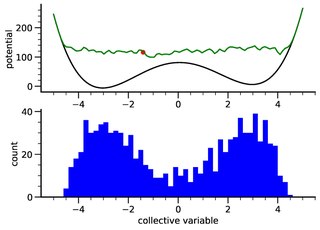Related Research Articles
NWChem is an ab initio computational chemistry software package which includes quantum chemical and molecular dynamics functionality. It was designed to run on high-performance parallel supercomputers as well as conventional workstation clusters. It aims to be scalable both in its ability to treat large problems efficiently, and in its usage of available parallel computing resources. NWChem has been developed by the Molecular Sciences Software group of the Theory, Modeling & Simulation program of the Environmental Molecular Sciences Laboratory (EMSL) at the Pacific Northwest National Laboratory (PNNL). The early implementation was funded by the EMSL Construction Project.

PLATO is a suite of programs for electronic structure calculations. It receives its name from the choice of basis set used to expand the electronic wavefunctions.
ABINIT is an open-source suite of programs for materials science, distributed under the GNU General Public License. ABINIT implements density functional theory, using a plane wave basis set and pseudopotentials, to compute the electronic density and derived properties of materials ranging from molecules to surfaces to solids. It is developed collaboratively by researchers throughout the world. A web-based easy-to-use graphical version, which includes access to a limited set of ABINIT's full functionality, is available for free use through the nanohub.
Ian Philip Grant, DPhil; FRS; CMath; FIMA, FRAS, FInstP is a British mathematical physicist. He is Emeritus Professor of Mathematical Physics at the University of Oxford and was elected a fellow of the Royal Society in 1992. He is a pioneer in the field of computational physics and is internationally recognised as the principal author of GRASP, the General Relativistic Atomic Structure Program.
Large-scale Atomic/Molecular Massively Parallel Simulator (LAMMPS) is a molecular dynamics program from Sandia National Laboratories. LAMMPS makes use of Message Passing Interface (MPI) for parallel communication and is free and open-source software, distributed under the terms of the GNU General Public License.
CLHEP is a C++ library that provides utility classes for general numerical programming, vector arithmetic, geometry, pseudorandom number generation, and linear algebra, specifically targeted for high energy physics simulation and analysis software. The project is hosted by CERN and currently managed by a collaboration of researchers from CERN and other physics research laboratories and academic institutions. According to the project's website, CLHEP is in maintenance mode.
In molecular dynamics (MD) simulations, the flying ice cube effect is an artifact in which the energy of high-frequency fundamental modes is drained into low-frequency modes, particularly into zero-frequency motions such as overall translation and rotation of the system. The artifact derives its name from a particularly noticeable manifestation that arises in simulations of particles in vacuum, where the system being simulated acquires high linear momentum and experiences extremely damped internal motions, freezing the system into a single conformation reminiscent of an ice cube or other rigid body flying through space. The artifact is entirely a consequence of molecular dynamics algorithms and is wholly unphysical, since it violates the principle of equipartition of energy.

Molecular modeling on GPU is the technique of using a graphics processing unit (GPU) for molecular simulations.

Molecular Dynamics of Mixtures (MDynaMix) is a computer software package for general purpose molecular dynamics to simulate mixtures of molecules, interacting by AMBER- and CHARMM-like force fields in periodic boundary conditions. Algorithms are included for NVE, NVT, NPT, anisotropic NPT ensembles, and Ewald summation to treat electrostatic interactions. The code was written in a mix of Fortran 77 and 90. The package runs on Unix and Unix-like (Linux) workstations, clusters of workstations, and on Windows in sequential mode.
Desmond is a software package developed at D. E. Shaw Research to perform high-speed molecular dynamics simulations of biological systems on conventional computer clusters. The code uses novel parallel algorithms and numerical methods to achieve high performance on platforms containing multiple processors, but may also be executed on a single computer.
Particle–Particle–Particle–Mesh (P3M) is a Fourier-based Ewald summation method to calculate potentials in N-body simulations.
This is a list of notable computer programs that are used for nucleic acids simulations.

Ascalaph Designer is a computer program for general purpose molecular modelling for molecular design and simulations. It provides a graphical environment for the common programs of quantum and classical molecular modelling ORCA, NWChem, Firefly, CP2K and MDynaMix . The molecular mechanics calculations cover model building, energy optimizations and molecular dynamics. Firefly covers a wide range of quantum chemistry methods. Ascalaph Designer is free and open-source software, released under the GNU General Public License, version 2 (GPLv2).

Metadynamics is a computer simulation method in computational physics, chemistry and biology. It is used to estimate the free energy and other state functions of a system, where ergodicity is hindered by the form of the system's energy landscape. It was first suggested by Alessandro Laio and Michele Parrinello in 2002 and is usually applied within molecular dynamics simulations. MTD closely resembles a number of newer methods such as adaptively biased molecular dynamics, adaptive reaction coordinate forces and local elevation umbrella sampling. More recently, both the original and well-tempered metadynamics were derived in the context of importance sampling and shown to be a special case of the adaptive biasing potential setting. MTD is related to the Wang–Landau sampling.
Quantemol Ltd is based in University College London initiated by Professor Jonathan Tennyson FRS and Dr. Daniel Brown in 2004. The company initially developed a unique software tool, Quantemol-N, which provides full accessibility to the highly sophisticated UK molecular R-matrix codes, used to model electron polyatomic molecule interactions. Since then Quantemol has widened to further types of simulation, with plasmas and industrial plasma tools, in Quantemol-VT in 2013 and launched in 2016 a sustainable database Quantemol-DB, representing the chemical and radiative transport properties of a wide range of plasmas.

The Open Exoplanet Catalogue is a catalogue of all discovered extra-solar planets. It is a new kind of astronomical database decentralized and completely open.

ms2 is a non-commercial molecular simulation program. It comprises both molecular dynamics and Monte Carlo simulation algorithms. ms2 is designed for the calculation of thermodynamic properties of fluids. A large number of thermodynamic properties can be readily computed using ms2, e.g. phase equilibrium, transport and caloric properties. ms2 is limited to homogeneous state simulations.
Trihydrogen oxide is a predicted inorganic compound of hydrogen and oxygen with the chemical formula H3O. This is still a hypothetical compound, one of the unstable hydrogen polyoxides. It is forecasted that the compound could constitute a thin layer of metallic liquid around the cores of Uranus and Neptune, being the source of their magnetic fields. Calculations indicate the stability of H3O in solid, superionic, and fluid metallic states at the deep interior conditions of these planets.
References
- ↑ Bonomi, Massimiliano; Branduardi, Davide; Bussi, Giovanni; Camilloni, Carlo; Provasi, Davide; Raiteri, Paolo; Donadio, Davide; Marinelli, Fabrizio; Pietrucci, Fabio (2009-10-01). "PLUMED: A portable plugin for free-energy calculations with molecular dynamics". Computer Physics Communications. 180 (10): 1961–1972. arXiv: 0902.0874 . Bibcode:2009CoPhC.180.1961B. doi:10.1016/j.cpc.2009.05.011. ISSN 0010-4655. S2CID 4852774.
- ↑ Tribello, Gareth A.; Bonomi, Massimiliano; Branduardi, Davide; Camilloni, Carlo; Bussi, Giovanni (2014-02-01). "PLUMED 2: New feathers for an old bird". Computer Physics Communications. 185 (2): 604–613. arXiv: 1310.0980 . Bibcode:2014CoPhC.185..604T. doi:10.1016/j.cpc.2013.09.018. ISSN 0010-4655. S2CID 17904052.
- ↑ Biarnés, Xevi; Pietrucci, Fabio; Marinelli, Fabrizio; Laio, Alessandro (2012-01-01). "METAGUI. A VMD interface for analyzing metadynamics and molecular dynamics simulations". Computer Physics Communications. 183 (1): 203–211. Bibcode:2012CoPhC.183..203B. doi:10.1016/j.cpc.2011.08.020. ISSN 0010-4655.
- ↑ "PLUMED: Introduction". www.plumed.org. Retrieved 2019-05-23.